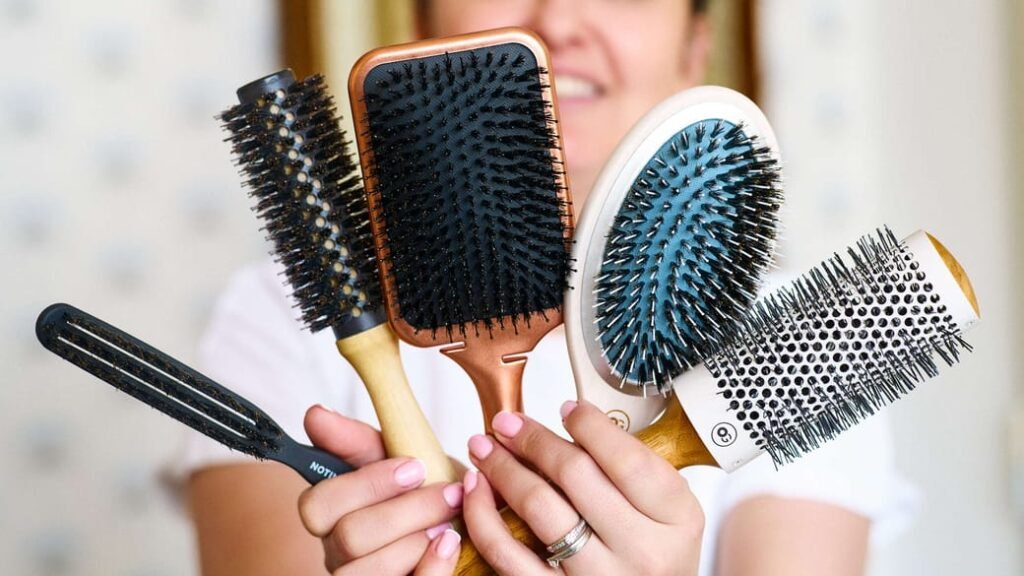A hair brush is more than just a styling tool—it is essential for maintaining the health, shine, and overall appearance of your hair. While brushing may seem like a simple daily routine, the way you use your brush can make a significant difference in how your hair looks and feels. Unfortunately, many people unknowingly make mistakes while brushing that lead to breakage, frizz, or even long-term damage. By understanding these common errors, you can take steps to improve your brushing habits and keep your hair healthier.
Choosing the right Hair Brush is the first step toward proper care, but knowing how to use it correctly is just as important. A good brush distributes natural oils, detangles gently, and promotes scalp health. However, if you use it incorrectly, even the best-quality brush won’t deliver the results you’re hoping for.
Brushing Too Aggressively
One of the most common mistakes is brushing with too much force. Aggressive strokes may seem like a quick solution for tangles, but they often cause strands to snap and lead to split ends. Instead, brushing should be done with controlled, gentle movements. Start from the ends and gradually work your way up to the roots to avoid unnecessary tension.
Using the Wrong Brush for Your Hair Type
Not all brushes are suitable for every hair type. Thick, curly hair needs brushes with wide-spaced bristles, while fine or straight hair benefits from softer, closely spaced bristles. Using the wrong type of brush can lead to increased breakage, frizz, and an unpolished finish. Matching your brush to your hair’s texture ensures smoother styling and healthier results.
Brushing Wet Hair with the Wrong Tool
Wet hair is especially fragile because its structure is temporarily weakened. Brushing it with a standard brush can cause stretching and breakage. Instead, use a wide-tooth comb or a brush specifically designed for wet hair. This prevents damage while still allowing you to detangle effectively.
Over-Brushing Your Hair
While brushing distributes oils and smooths strands, too much brushing can strip your hair of natural moisture and cause breakage. Contrary to the old myth of “100 strokes a day,” most people only need to brush once or twice daily. Anything beyond that can place unnecessary stress on the cuticle, leading to dryness and split ends.
Ignoring Tangles and Knots
Another mistake is forcing the brush through stubborn tangles. This aggressive action pulls on the hair shaft and damages the cuticle. Instead, gently work through knots by holding the section of hair firmly in one hand and slowly detangling small portions at a time. Patience during this process helps preserve your hair’s integrity.
Not Cleaning Your Brush Regularly
Many people overlook the importance of cleaning their brush. Over time, hair, oil, dust, and product residue build up on bristles, reducing their effectiveness and transferring buildup back onto your scalp. Regularly removing trapped hair and washing your brush with mild shampoo ensures it remains hygienic and effective. A clean brush also minimizes friction, which helps prevent breakage.
Using Old or Damaged Brushes
A brush with broken or worn-out bristles can do more harm than good. Damaged bristles may scratch the scalp or snag hair, increasing the risk of split ends. It’s essential to replace your brush when you notice visible signs of wear, such as bent, missing, or rough bristles. Investing in a quality brush and replacing it when necessary helps maintain smooth, healthy strands.
Brushing Too Quickly
Rushing through brushing often leads to careless movements that tug and pull at the hair. This habit creates unnecessary stress on the strands, making them prone to snapping. Taking a few extra minutes to brush slowly and methodically not only prevents damage but also allows the brush to distribute oils more evenly for a shinier finish.
Benefits of wooden Hair Brush
Here’s a clear breakdown of the benefits of using a wooden hair brush:
1. Gentle on Hair and Scalp
Wooden bristles are smoother and rounder than plastic or metal ones, reducing breakage and split ends. They glide through hair without causing static or snagging.
2. Natural Scalp Stimulation
The wooden tips massage the scalp gently, improving blood circulation. This helps deliver more nutrients and oxygen to the hair roots, promoting healthier growth.
3. Distributes Natural Oils Evenly
A wooden hair brush spreads your scalp’s natural oils from root to tip, giving your hair a natural shine while preventing an oily scalp and dry ends.
4. Reduces Frizz and Static
Unlike plastic brushes, wood does not create static electricity. This means smoother hair with less frizz, making it easier to manage.
5. Eco-Friendly Choice
Wooden brushes are usually made from sustainable materials, making them biodegradable and environmentally friendly compared to plastic alternatives.
6. Suitable for All Hair Types
Whether you have curly, straight, thick, or thin hair, wooden brushes work well without pulling or damaging strands.
7. Promotes Relaxation
The gentle massaging effect of wooden bristles can help reduce stress, ease scalp tension, and create a calming grooming routine.
8. Durable and Long-Lasting
High-quality wooden brushes are sturdy and can last for years if cared for properly, making them a cost-effective choice.
Final Thoughts
Brushing your hair may seem like a simple task, but the way you do it can either enhance or harm your hair’s health. By avoiding common mistakes such as aggressive brushing, using the wrong tools, or neglecting brush care, you can protect your strands from damage and promote smoother, shinier results. The key is to choose the right brush for your hair type, maintain it properly, and brush with patience and care. With these adjustments, you’ll enjoy healthier, stronger, and more beautiful hair every day.
